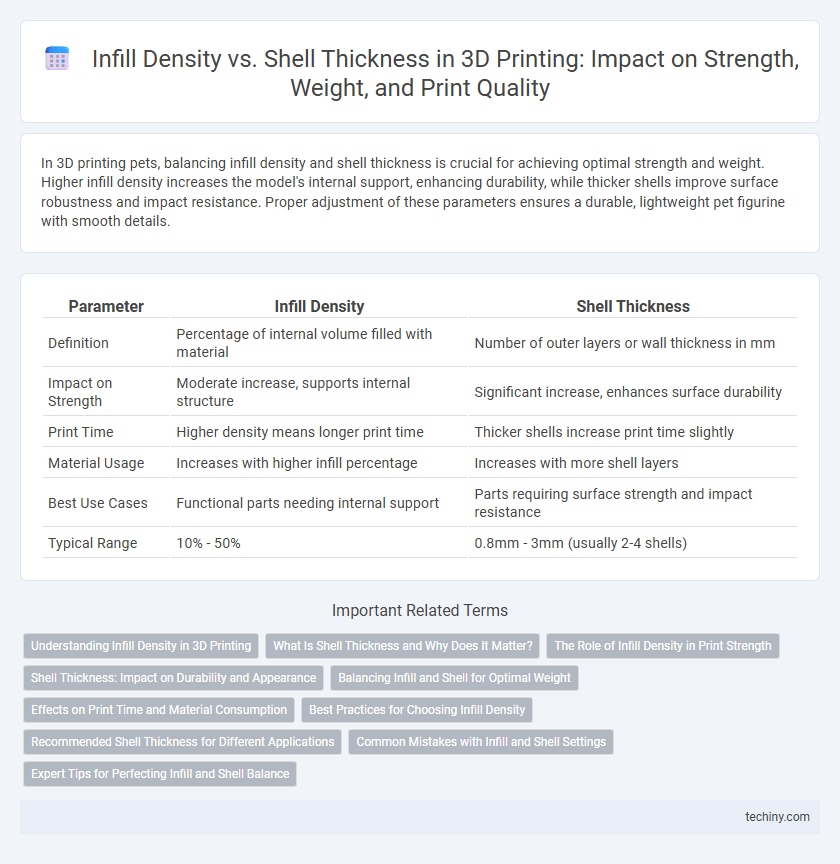In 3D printing pets, balancing infill density and shell thickness is crucial for achieving optimal strength and weight. Higher infill density increases the model's internal support, enhancing durability, while thicker shells improve surface robustness and impact resistance. Proper adjustment of these parameters ensures a durable, lightweight pet figurine with smooth details.
Table of Comparison
| Parameter | Infill Density | Shell Thickness |
|---|---|---|
| Definition | Percentage of internal volume filled with material | Number of outer layers or wall thickness in mm |
| Impact on Strength | Moderate increase, supports internal structure | Significant increase, enhances surface durability |
| Print Time | Higher density means longer print time | Thicker shells increase print time slightly |
| Material Usage | Increases with higher infill percentage | Increases with more shell layers |
| Best Use Cases | Functional parts needing internal support | Parts requiring surface strength and impact resistance |
| Typical Range | 10% - 50% | 0.8mm - 3mm (usually 2-4 shells) |
Understanding Infill Density in 3D Printing
Infill density in 3D printing determines the internal structure's solidity, directly impacting the object's strength, weight, and material consumption. Higher infill percentages increase durability and rigidity but also extend print time and use more filament. Optimizing infill density according to the functional requirements of the printed part ensures efficient material use while maintaining desired mechanical properties.
What Is Shell Thickness and Why Does It Matter?
Shell thickness refers to the number of outer layers or walls of a 3D print, providing structural strength and surface quality. Increasing shell thickness enhances durability, impact resistance, and prevents print failures by reinforcing the exterior, while lower shell thickness reduces material use but compromises robustness. Optimal shell thickness balances strength requirements and material efficiency, crucial for functional parts and high-precision models in 3D printing.
The Role of Infill Density in Print Strength
Infill density plays a critical role in determining the strength and durability of 3D printed objects by providing internal support that resists external forces. Higher infill densities enhance load-bearing capacity and reduce deformation, contributing directly to the mechanical integrity of the print. Optimizing infill density balances material usage and print time with the desired strength requirements, often working in tandem with shell thickness to maximize overall structural performance.
Shell Thickness: Impact on Durability and Appearance
Shell thickness in 3D printing directly influences the part's durability by enhancing its structural integrity and resistance to external forces. Increasing shell thickness results in a smoother surface finish, improving the appearance and reducing visible layer lines. Optimal shell thickness balances strength and material usage, ensuring robust prints without excessive weight or print time.
Balancing Infill and Shell for Optimal Weight
Balancing infill density and shell thickness is crucial for optimizing weight without compromising structural integrity in 3D printing. Higher shell thickness enhances surface strength and impact resistance, while moderate infill density reduces weight and material usage. Ideal settings typically involve combining a robust shell with a lighter infill pattern to achieve strength where needed and minimize overall mass.
Effects on Print Time and Material Consumption
Infill density directly impacts print time and material consumption by increasing the amount of internal filling, leading to longer prints and higher material use. Shell thickness influences both structural strength and surface durability while contributing moderately to total print time and filament usage compared to infill density. Balancing infill density and shell thickness is essential for optimizing print efficiency without compromising mechanical stability or material cost.
Best Practices for Choosing Infill Density
Selecting the right infill density balances strength, weight, and material usage in 3D printing. A higher infill density increases part durability but consumes more filament and print time, whereas a lower density reduces weight and cost but may compromise structural integrity. Best practices recommend using 20-30% infill for functional prototypes and up to 50% or more for load-bearing parts, while adjusting shell thickness to enhance external strength without excessive material waste.
Recommended Shell Thickness for Different Applications
Recommended shell thickness varies by application, typically ranging from 0.8 mm for lightweight prototypes to 2.4 mm for functional parts requiring high durability. Thin shells around 0.8-1.2 mm are suited for aesthetic models with minimal mechanical stress, while thicker shells of 2.0-2.4 mm enhance strength and impact resistance in load-bearing components. Adjusting shell thickness in conjunction with infill density optimizes print strength, surface finish, and material usage for specific end-use scenarios.
Common Mistakes with Infill and Shell Settings
Incorrectly balancing infill density and shell thickness often leads to either weak prints or excessive material use, compromising print strength and efficiency. Many users underestimate the importance of adequate shell thickness, which can cause surface defects and structural failure despite a high infill percentage. Optimal 3D printing requires precise calibration to ensure shells provide proper support while infill density reinforces internal stability without unnecessary filament consumption.
Expert Tips for Perfecting Infill and Shell Balance
Expert tips for perfecting the balance between infill density and shell thickness emphasize optimizing structural integrity while minimizing material usage in 3D printing. Increasing shell thickness enhances external strength and impact resistance, whereas adjusting infill density directly influences internal support and weight reduction. Achieving the ideal combination depends on the specific mechanical requirements and print purpose, with common settings ranging from 10-20% infill density paired with 2-4 shell layers for durable yet efficient prints.
Infill Density vs Shell Thickness Infographic

 techiny.com
techiny.com